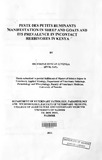| dc.description.abstract | Peste des petits ruminants (PPR) is a highly devastating viral disease of sheep and goats. PPR was confirmed to be occurring in Kenyan goat and sheep populations in March 2006 in Turkana district. The disease has since spread to other districts of Kenya. The confirmation and clinical presentation of PPR in the Kenyan goat and sheep populations as it occurred was hitherto not described. There was need to confirm that the outbreaks that occurred in Kenya were due to PPR as some of the signs that occur due to PPR are shared by other diseases. The aim of this study was to confirm the occurrence of PPR, document the clinical picture, management and risk factors that were associated with the PPR disease as it occurred in Kenya during the 2007-2008 outbreak. In addition the study sought to find out whether in-contact domestic and wild herbivores got natural exposure and infection with the PPR virus. Occurrence of PPR was confirmed in goats by carrying out PCR test on ten nasal and ocular swab samples collected from Marakwet East district in May 2008. In order to determine the clinical picture, management and risk factors of PPR, 78 questionnaires were administered to livestock keepers in Tot division of Marakwet East district in November 2009. This was followed by determination of PPR seroprevalence by carrying out cELISA on cattle, camel, buffalo, giraffe and warthog serum samples. In total, 240 cattle serum samples were tested, 160 for camel, 98 for buffalo, 93 for warthog and 9 for giraffe. Thirty three goat serum samples were also tested to find out whether the virus had infected goats bom five months after vaccination.
In this study, nasal and eye swabs from a female goat were positive for PPR RNA on PCR. The study further showed that Marakwet community largely practices pastoralism with sheep and goats being the most reared animals. Diseases were the biggest threat to livestock production amongst other challenges. Among the diseases
affecting the small stock contagious caprine pleuropneumonia (CCPP) topped the list, followed by heartwater and PPR came third. The clinical signs of PPR recorded included loss of appetite, ocular discharge, nasal discharge, diarrhoea, rough hair coat, coughing and death. I here were no mouth lesions reported. The questionnaire survey also showed that 37.2% of livestock keepers opened up carcasses of animals dying of PPR. The post mortem signs observed included darkening or reddening of lungs, haemorrhages in the small intestines, impaction of the reticulum, oedema along the mesentry and the enlargement of lymphnodes. As a result of the disease, the study showed that livestock keepers and other players in the livestock industry suffered loss of income, loss of human food, loss of markets and losses arising from impact of imposed quarantines. The cELISA test results showed an overall PPR seroprevalence of 4.2% in cattle, 3.13% in camel and a locality specific PPR seroprevalence of 21.2%. Samples from the three wildlife species were negative for PPR antibodies.
The results of this study showed that the PPR disease as it occurred in Kenya was non-classical. This has the implication of poor recognition and reporting by livestock keepers. Continued surveillance mechanism therefore needs to be put in place to avoid disease flare up especially after a build up of a susceptible population. It is therefore recommended that vaccination against PPR be combined with the more prevalent diseases like CCPP. The results of this study further demonstrated that cattle and camel populations of Kenya got exposed to PPR virus and developed antibodies against this disease. As such, the incontact animals (cattle and camel) can be used as indicators (sentinel herds) for evaluation of increased PPR virus circulation among sheep and goat populations especially in the arid and semi-arid lands (ASALs) of Kenya where these different livestock species are herded together | |

